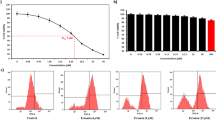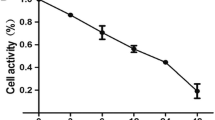Abstract
Casticin, a flavonoid isolated from Vitex species, has been found to have anti-tumor property in multiple human cancers. The present study aimed to investigate the effect of casticin on the proliferation and apoptosis of esophageal cancer (EC) cells, and further illustrate the underlying mechanisms. In in vitro studies, human EC cell lines TE-1 and ECA-109 were treated with various concentrations of casticin (low-, middle-, and high-dose groups). The results showed that casticin dose-dependently inhibited the proliferation and clonogenicity of EC cells and induced cell cycle arrest in sub-G1 and G2 phases. Furthermore, casticin markedly enhanced EC cell apoptosis as detected by flow cytometry and Hoechst 33342 staining. The level of anti-apoptotic Bcl-2 protein was decreased, while the levels of pro-apoptotic Bax, cleaved-caspase-3, cleaved-caspase-9, and cleaved-PARP were conversely increased in casticin-treated TE-1 and ECA-109 cells. Moreover, casticin decreased the mitochondrial membrane potential and increased the release of mitochondrial cytochrome C into cytoplasm. In addition, the JNK signaling pathway was involved in casticin-medicated anti-proliferation and pro-apoptosis. Cells pretreated with SP600125, a JNK pathway inhibitor, partially abolished the effect of casticin. Finally, the anti-tumor property of casticin was confirmed in in vivo xenograft models. Overall, we provided both in vitro and in vivo evidences that casticin inhibited the proliferation and induced apoptosis of EC cells, and the anti-tumor action of casticin was mediated, in part, by the mitochondrial-dependent apoptosis and the activation of JNK signaling pathway.





Similar content being viewed by others
References
Chan EWC, Wong SK, Chan HT (2018) Casticin from Vitex species: a short review on its anticancer and anti-inflammatory properties. J Integr Med 16:147–152. https://doi.org/10.1016/j.joim.2018.03.001
Chen D, Cao J, Tian L, Liu F, Sheng X (2011) Induction of apoptosis by casticin in cervical cancer cells through reactive oxygen species-mediated mitochondrial signaling pathways. Oncol Rep 26:1287–1294. https://doi.org/10.3892/or.2011.1367
Choudhary MI, Jalil S, Nawaz SA, Khan KM, Tareen RB (2009) Antiinflammatory and lipoxygenase inhibitory compounds from Vitex agnus-castus. Phytother Res 23:1336–1339. https://doi.org/10.1002/ptr.2639
Chung YH, Kim D (2016) RIP kinase-mediated ROS production triggers XAF1 expression through activation of TAp73 in casticin-treated bladder cancer cells. Oncol Rep 36:1135–1142. https://doi.org/10.3892/or.2016.4895
Dai Y, Cheng R, Gao J, Li Y, Lou C (2018) Casticin inhibits PDGF-induced proliferation and migration of airway smooth muscle cells. Eur J Pharmacol 830:39–46. https://doi.org/10.1016/j.ejphar.2018.04.016
de Sampaio e Spohr TC et al (2010) Effects of the flavonoid casticin from Brazilian Croton betulaster in cerebral cortical progenitors in vitro: direct and indirect action through astrocytes. J Neurosci Res 88:530–541. https://doi.org/10.1002/jnr.22218
Elford BC, Roberts MF, Phillipson JD, Wilson RJ (1987) Potentiation of the antimalarial activity of qinghaosu by methoxylated flavones. Trans R Soc Trop Med Hyg 81:434–436
Ghobrial IM, Witzig TE, Adjei AA (2005) Targeting apoptosis pathways in cancer therapy. CA Cancer J Clin 55:178–194
Hajdu Z et al (2007) Diterpenoids and flavonoids from the fruits of Vitex agnus-castus and antioxidant activity of the fruit extracts and their constituents. Phytother Res 21:391–394. https://doi.org/10.1002/ptr.2021
Hajnoczky G, Hoek JB (2007) Cell signaling. Mitochondrial longevity pathways. Science 315:607–609. https://doi.org/10.1126/science.1138825
Hengartner MO (2000) The biochemistry of apoptosis. Nature 407:770–776. https://doi.org/10.1038/35037710
Hu Y, Xin HL, Zhang QY, Zheng HC, Rahman K, Qin LP (2007) Anti-nociceptive and anti-hyperprolactinemia activities of Fructus Viticis and its effective fractions and chemical constituents. Phytomedicine 14:668–674. https://doi.org/10.1016/j.phymed.2007.01.008
Ji RR, Gereau RW, Malcangio M, Strichartz GR (2009) MAP kinase and pain. Brain Res Rev 60:135–148. https://doi.org/10.1016/j.brainresrev.2008.12.011
Joza N, Susin SA, Daugas E, Stanford WL, Cho SK, Li CYJ, Sasaki T, Elia AJ, Cheng HYM, Ravagnan L, Ferri KF, Zamzami N, Wakeham A, Hakem R, Yoshida H, Kong YY, Mak TW, Zúñiga-Pflücker JC, Kroemer G, Penninger JM (2001) Essential role of the mitochondrial apoptosis-inducing factor in programmed cell death. Nature 410:549–554. https://doi.org/10.1038/35069004
Lee H, Jung KH, Park S, Choi W, Bae H (2015) Casticin, an active compound isolated from Vitex Fructus, ameliorates the cigarette smoke-induced acute lung inflammatory response in a murine model. Int Immunopharmacol 28:1097–1101. https://doi.org/10.1016/j.intimp.2015.07.041
Leibowitz B, Yu J (2010) Mitochondrial signaling in cell death via the Bcl-2 family. Cancer Biol Ther 9:417–422
Liu E, Kuang Y, He W, Xing X, Gu J (2013) Casticin induces human glioma cell death through apoptosis and mitotic arrest. Cell Physiol Biochem 31:805–814. https://doi.org/10.1159/000350098
Liu LP, Cao XC, Liu F, Quan MF, Sheng XF, Ren KQ (2014) Casticin induces breast cancer cell apoptosis by inhibiting the expression of forkhead box protein M1. Oncol Lett 7:1711–1717. https://doi.org/10.3892/ol.2014.1911
Napier KJ, Scheerer M, Misra S (2014) Esophageal cancer: a review of epidemiology, pathogenesis, staging workup and treatment modalities. World J Gastrointest Oncol 6:112–120. https://doi.org/10.4251/wjgo.v6.i5.112
Pennathur A, Gibson MK, Jobe BA, Luketich JD (2013) Oesophageal carcinoma. Lancet 381:400–412. https://doi.org/10.1016/S0140-6736(12)60643-6
Qu L, Liu FX, Cao XC, Xiao Q, Yang X, Ren KQ (2014) Activation of the apoptosis signal-regulating kinase 1/c-Jun N-terminal kinase pathway is involved in the casticin-induced apoptosis of colon cancer cells. Exp Ther Med 8:1494–1500. https://doi.org/10.3892/etm.2014.1934
Rasul A, Zhao BJ, Liu J, Liu B, Sun JX, Li J, Li XM (2014) Molecular mechanisms of casticin action: an update on its antitumor functions. Asian Pac J Cancer Prev 15:9049–9058
Schapira AH (2012) Mitochondrial diseases. Lancet 379:1825–1834. https://doi.org/10.1016/S0140-6736(11)61305-6
Shang HS, Liu JY, Lu HF, Chiang HS, Lin CH, Chen A, Lin YF, Chung JG (2017) Casticin induced apoptotic cell death and altered associated gene expression in human colon cancer Colo 205 cells. Environ Toxicol 32:2041–2052. https://doi.org/10.1002/tox.22381
Shen JK, Du HP, Yang M, Wang YG, Jin J (2009) Casticin induces leukemic cell death through apoptosis and mitotic catastrophe. Ann Hematol 88:743–752. https://doi.org/10.1007/s00277-008-0677-3
Song XL, Zhang YJ, Wang XF, Zhang WJ, Wang Z, Zhang F, Zhang YJ, Lu JH, Mei JW, Hu YP, Chen L, Li HF, Ye YY, Liu YB, Gu J (2017) Casticin induces apoptosis and G0/G1 cell cycle arrest in gallbladder cancer cells. Cancer Cell Int 17:9. https://doi.org/10.1186/s12935-016-0377-3
Zeng F, Tian L, Liu F, Cao J, Quan M, Sheng X (2012) Induction of apoptosis by casticin in cervical cancer cells: reactive oxygen species-dependent sustained activation of Jun N-terminal kinase. Acta Biochim Biophys Sin 44:442–449. https://doi.org/10.1093/abbs/gms013
Zhou Y, Tian L, Long L, Quan M, Liu F, Cao J (2013) Casticin potentiates TRAIL-induced apoptosis of gastric cancer cells through endoplasmic reticulum stress. PLoS One 8:e58855. https://doi.org/10.1371/journal.pone.0058855
Funding
This study was supported by a grant from the Science and Technology Development Project of Shaanxi Province (No. S2015YFSF0111).
Author information
Authors and Affiliations
Contributions
ZQ conceived and designed study; ZQ, YC, and SLiu performed experiments; ZQ, ZM, SLi, and WZ analyzed data. ZQ and YC wrote the manuscript.
Corresponding author
Ethics declarations
Conflict of interest
The authors declare that they have no conflict of interest.
Ethical approval
All the animal experiments were conducted in strict accordance with the Guidelines for the care and use of laborary animals and were approved by the Experimental Animal Ethics of the Second Affiliated Hospital of Xi’an Jiaotong University.
Rights and permissions
About this article
Cite this article
Qiao, Z., Cheng, Y., Liu, S. et al. Casticin inhibits esophageal cancer cell proliferation and promotes apoptosis by regulating mitochondrial apoptotic and JNK signaling pathways. Naunyn-Schmiedeberg's Arch Pharmacol 392, 177–187 (2019). https://doi.org/10.1007/s00210-018-1574-5
Received:
Accepted:
Published:
Issue Date:
DOI: https://doi.org/10.1007/s00210-018-1574-5




